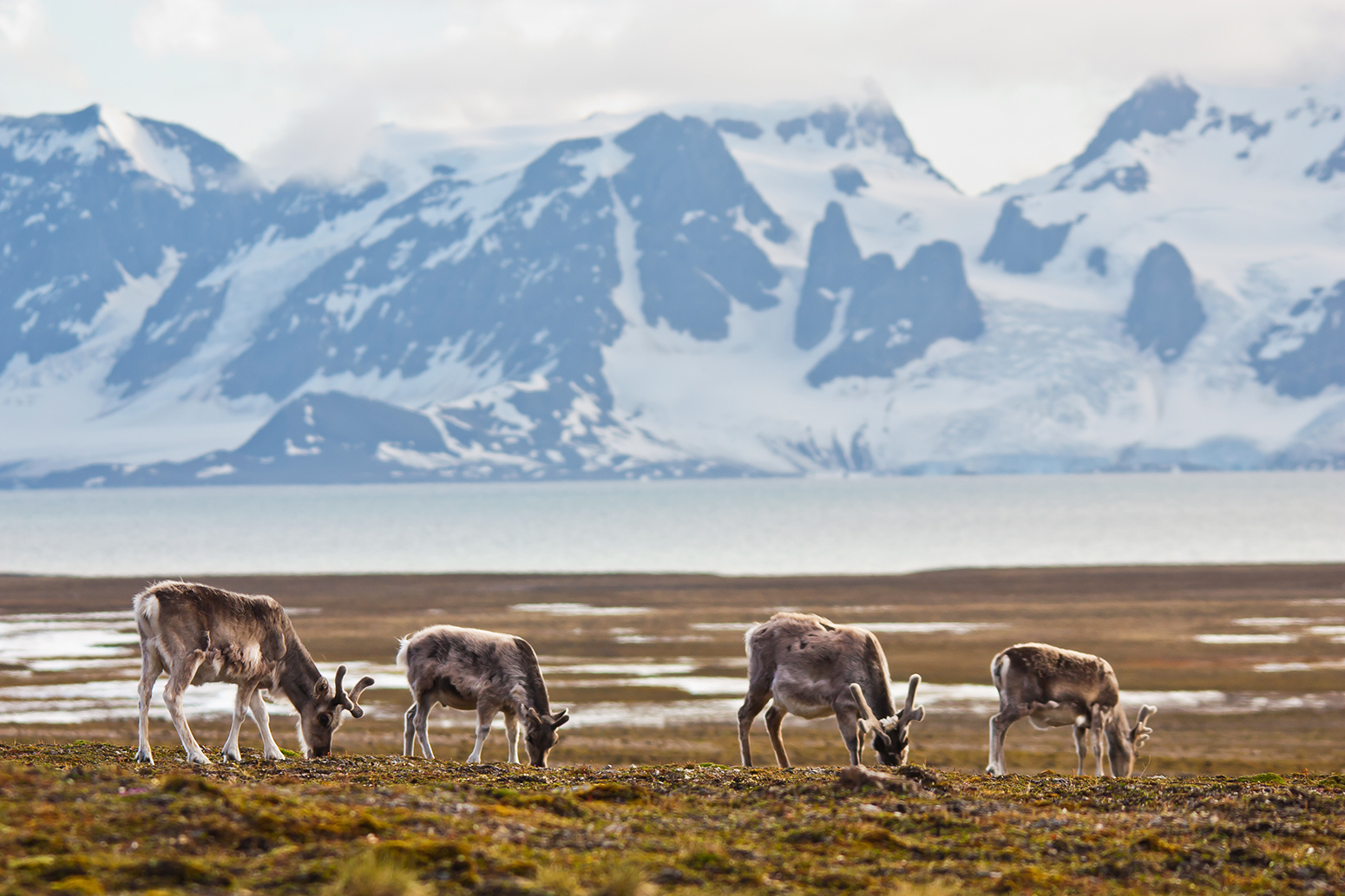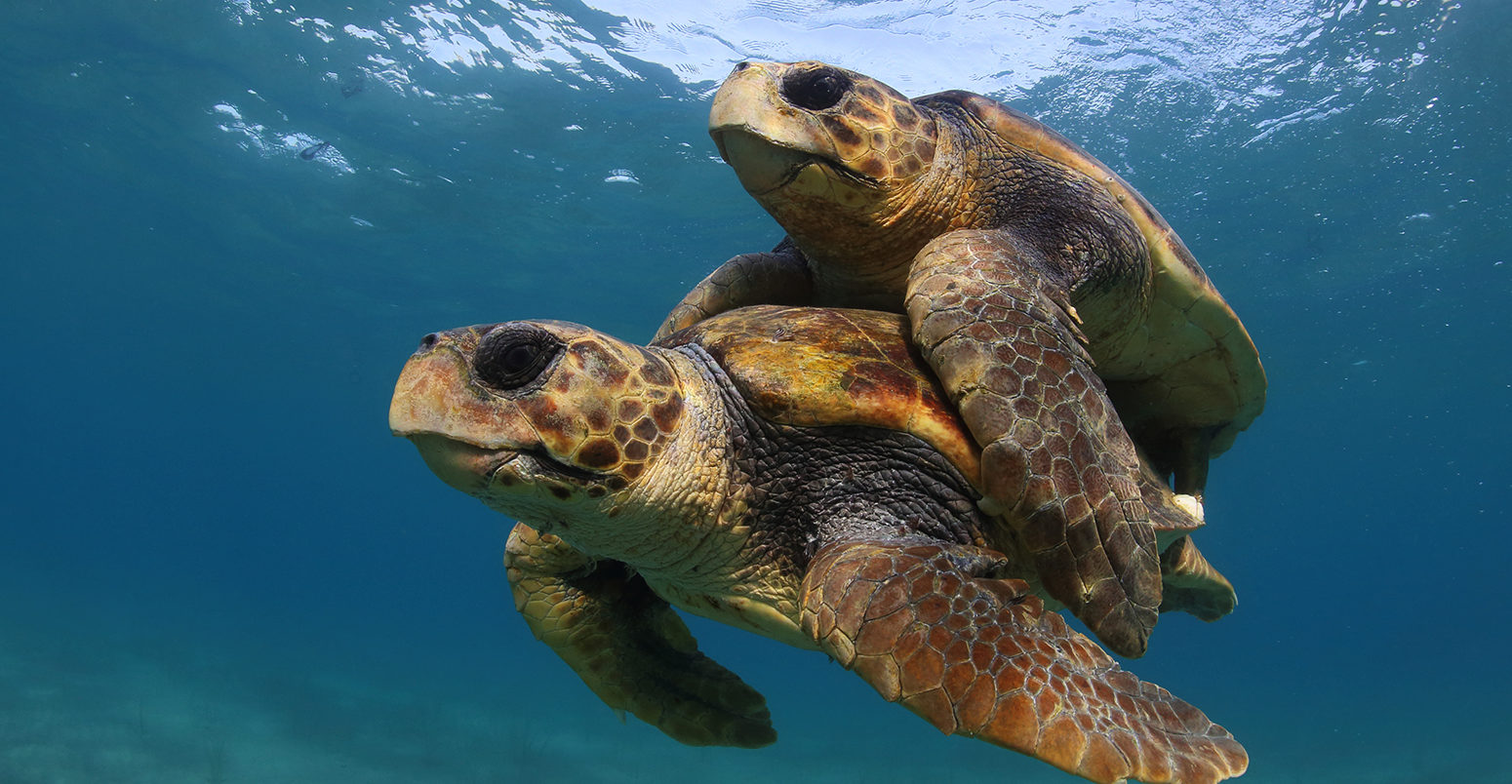
In-depth: How will climate change affect animal sex ratios?
Daisy Dunne
10.23.17From habitat loss to extreme weather events, the world’s wildlife faces a list of challenges as a result of climate change.
But a growing field of research suggests that climate change could affect the numbers of males and females differently. An imbalance between the sexes in some animal populations could stifle reproduction, which could lead to population declines and even species extinctions.
Carbon Brief spoke to scientists who are studying how climate change could affect the sex ratios of a diverse group of animals.
Turtle trouble
Rising temperatures could spell trouble for animals that use temperature-dependent sex determination (TSD). This is when an animal’s gender is controlled by the temperature that an animal is exposed to while it is developing as an embryo or larvae.
Sea turtles are one group of animals that are subject to TSD. During the reproductive season, female sea turtles come ashore to bury their eggs in the sand. The temperature of the sand determines whether the clutch is born male or female. For most turtles, low temperatures result in an all-male clutch, while high temperatures result in an all-female clutch.
Because of this, scientists have expressed fears that a rise in global temperatures could lead to a large proportion of new turtle hatchlings being born female.
There is evidence that this may be happening already. In Florida, an important breeding spot for the loggerhead sea turtle, there has been a strong female bias in the hatchlings that have emerged over the past five years, reaching 95% female in some areas.
And in Cape Verde, another breeding ground for loggerhead turtles, the proportion of hatchlings being born female is thought to have risen from around 59% in the 1850s to close to 70% today.
However, it is not yet clear how any female bias will affect overall loggerhead population numbers, says Dr Jacques-Olivier Laloë, a researcher in turtle sex ratios from Swansea University.
He points out that female turtles may be able to cope with a shortage of males because they are able to store sperm. This means they can go long periods of time without encountering a male and still reproduce regularly.
On top of this, males are able to mate with multiple females during one season, meaning there does not necessarily need to be equal numbers of males and females for populations to thrive, says Laloë. He tells Carbon Brief:
“These factors change the story. What we’ve learned is, there doesn’t need to be one male for every female. As long as you have enough males to fertilise every female, then populations can continue to rise. But how many males is enough? That’s a question we’re still not very close to answering.”
Laloë’s research suggests that, as global temperatures continue to rise, the proportion of hatchlings that are born female will also increase. However, overall numbers of turtles are unlikely to be negatively affected.
But, at some point, turtle populations will reach a “tipping point” where there will not be enough males for mating to take place as normal and turtle populations could quickly collapse, says Laloë.
“Our current models suggest that, under a moderate warming scenario [RCP4.5], the year 2100 might be a turning point for turtles. After this, there could be not enough males to mate with all of the females and this could lead to population decline and increase the risk of extinction.”
However, if global CO2 emissions continue to rise unchecked, as in the RCP8.5 emissions scenario, then this tipping point could happen earlier, Laloë adds.
As well causing problems for turtles, climate change could skew the sex ratios of other animals that depend on TSD, including many other reptiles, as well as fish and alligators.
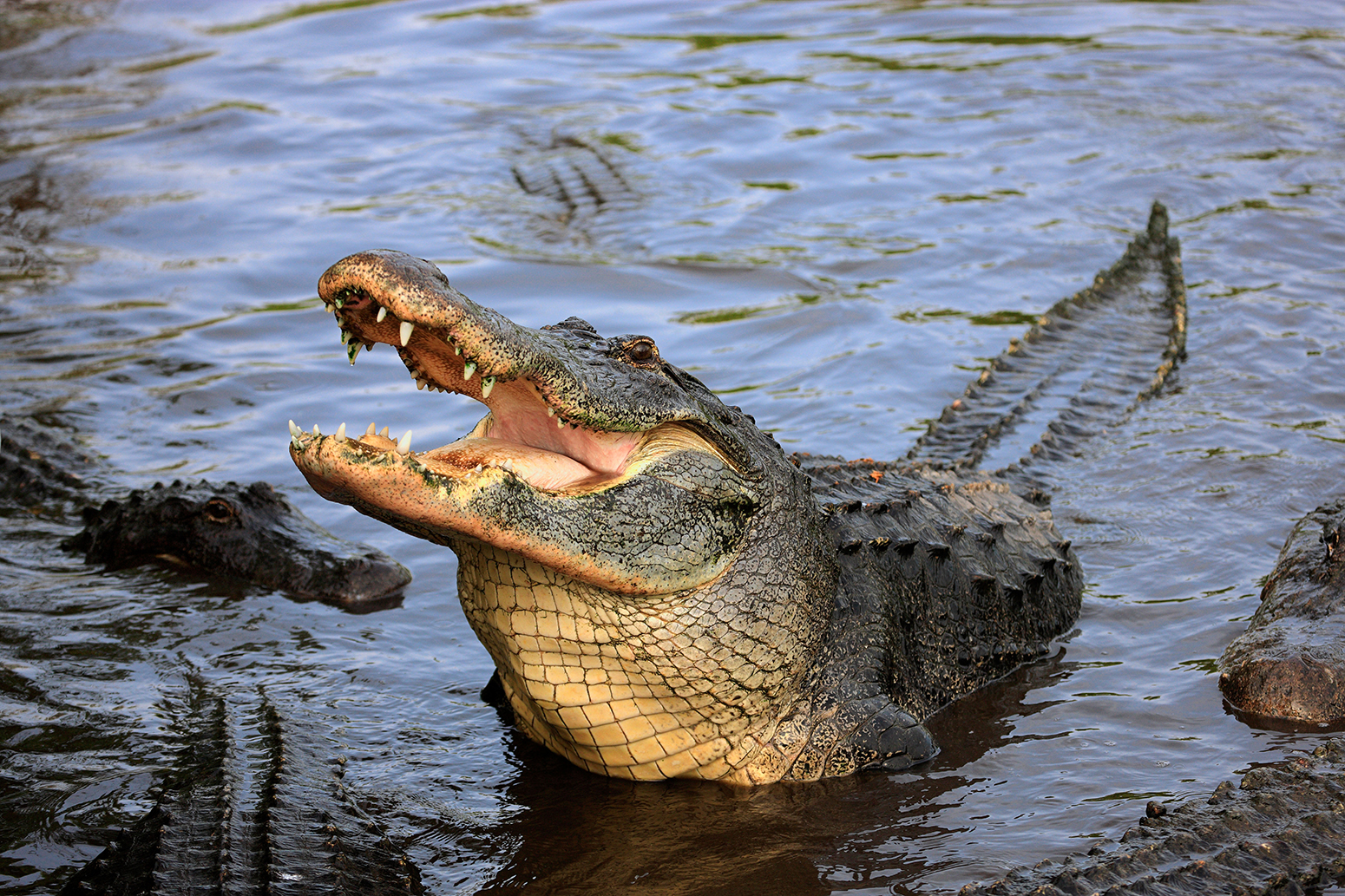
Adult American alligator (Alligator mississippiensis), Florida, US, 26/09/2008. Credit: imageBROKER/Alamy Stock Photo.
Researchers studying the American alligator have found that eggs incubated at a temperatures above 34C are born male, prompting fears that climate change could cause a male bias in populations.
A future shortage in females could very rapidly lead to a decline in reproduction and population collapse, Laloë says. “A surplus of males could potentially cause a much bigger problem than a surplus of females.”
How warming can influence genetics
For the majority of the animal kingdom, gender is controlled by genetics.
Mammals have an “XX/XY” sex determination system, where animals with a “Y” chromosome are born male. In contrast, birds, along with some fish and amphibians, have a “ZZ/ZW” sex determination system, where those with a “W” chromosome are born female.
Warming temperatures can complicate matters by causing something known as “sex reversal” (pdf). This is when exposure to warming during embryonic development causes an animal to have all the physical characteristics of one sex, but the genetic code for the other.
For many animals, exposure to high temperatures causes genetically female embryos to be born with the physical characteristics of a male. This is process is known as “masculinisation” and occurs because high temperatures are thought to promote the activity of male hormones.
Because of this, scientists have suggested that climate change could induce an overall male bias in species that have genetically-controlled sex determination.
However, this male bias could affect animals that have “ZZ/ZW” sex determination more than those that have “XX/XY”, a recent study finds.
This is because those with “XX/XY” sex determination have the ability to quickly offset a male bias. For instance, if a “masculinised” female with two “X” chromosomes mates with an unaltered female (who also has two “X” chromosomes) – then all of their offspring will be born female. This is because neither animal has a “Y” chromosome to pass on to their offspring. A surge in female births could counterbalance a male bias in just one generation, researchers say.
However, animals that have “ZZ/ZW” sex determination are less able to offset a male bias. If a “masculinised” female with “ZW” sex chromosomes mates with an unaffected female (also with “ZW” chromosomes), a quarter of all of their offspring will still be male (with “ZZ” chromosomes).
An increase in male births as a result of global warming could particularly threaten the survival of fish, reptiles and amphibians, says Dr Veronika Bókony, lead author of the research and ecologist at the Hungarian Academy of Sciences in Budapest. She tells Carbon Brief:
“The sexual development of mammalian and avian embryos is well protected from environmental temperatures in the womb or egg. Ectothermic [cold-blooded] animals, such as fish, amphibians, and reptiles, are more likely to be affected by masculinisation.
“However, it is not yet known (and very difficult to test) what caused those sex reversals, because not only extraordinary temperatures, but also chemical contaminants, such as pesticides and road de-icers, can interfere with sexual development.”
In her research, she created mathematical models to predict how a rise in masculinisation as a result of climate change could affect the survival of many species of fish, reptiles and amphibians. She says:
“[The risk of extinction] is definitely a possibility. We have estimated that it would take a few hundred years for temperature-induced masculinisation to drive many animal populations to extinction if climate warming continues at its current rate. However, we assumed that these populations were otherwise healthy and not affected by pollution, disease and habitat loss.”
The fight for survival
Even for species whose early development is completely unaffected by temperature, climate change could still play a role in skewing the ratio of males to females.
This is because climate change threatens the survival of males and females in different ways.
For example, recent research suggests that male reindeer may be more susceptible to climate change than females.
Halfway between Norway and the North Pole, Svalbard reindeer, the smallest subspecies of reindeer, roam the tundra of the Svalbard archipelago.
Climate change is expected to worsen winter feeding conditions on the archipelago because precipitation is increasingly likely to fall as rain rather than snow. Reindeer can push past snow to reach the vegetation on which they graze, but rain can freeze into hard ice, which they can’t break through.
This can cause a food shortage that has a disproportionate effect on males, the study finds. The research suggests that heavy winter rainfall is associated with an increase in the death of males, but not females, resulting in overall female bias at the start of spring.
The graphs below show the estimated effects of winter rainfall (a,c) and population size (b,d) on adult population growth rates of male (solid lines) and female (dashed lines) reindeer. The graph shows how the population growth rates of males drops below zero as winter rainfall increases, meaning that the overall number of males is expected to fall. In comparison, the population growth rate of females does not drop below zero, meaning that the overall number of females is expected to increase.
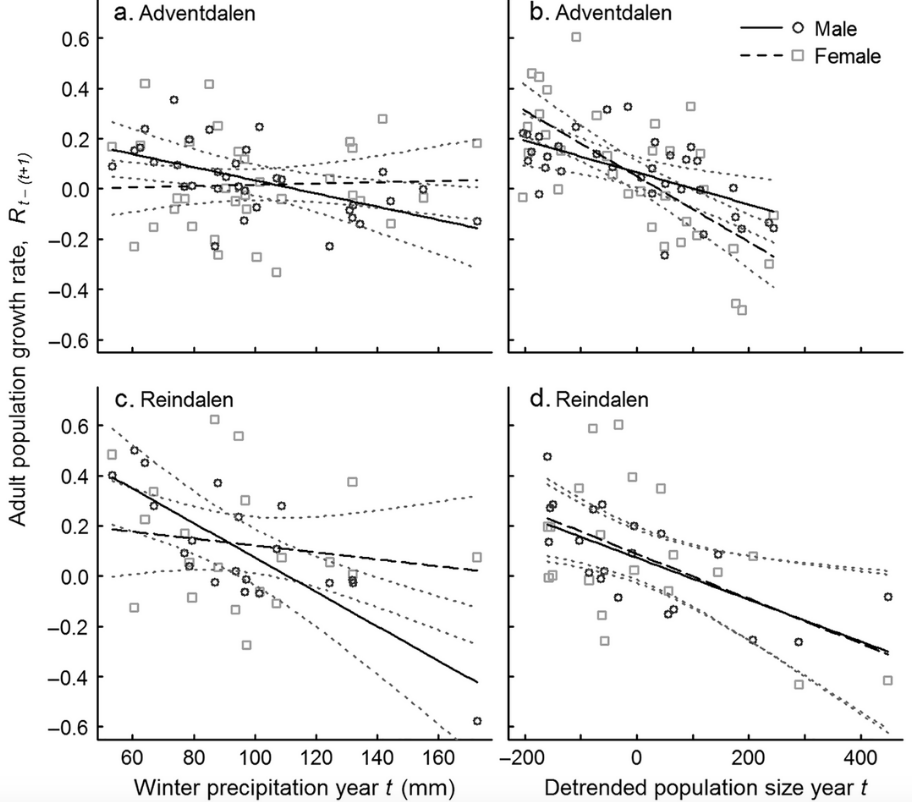
The estimated effects of winter rainfall (a,c) and population size (b,d) on adult population growth rates of males (solid lines) and females (dashed lines) of Svalbard reindeer populations in Adventdalen and Reindalen. Dotted lines indicate 95% confidence intervals. Source: Peeters et al. (2017)
To understand the difference in overwinter survival of males and females, researchers have been studying reindeer during the mating season (also called the rut), which takes place in the weeks approaching winter.
During the rut, males attempt to attract females by fighting and chasing each other, calling loudly and thrashing their antlers against trees. As a result, males exert a great deal of energy and have little time to find food. They can lose up to a third of their body weight during the rut, making them extremely vulnerable to food shortages in the winter.
The females, meanwhile, spend the mating season piling up on food in preparation for the harsh months ahead and so are better able to cope with the food shortages associated with climate change.
Females are only capable of giving birth to one calf per year and so have potentially a lot to gain, in the long-run, by prioritising their own survival into the years ahead, explains Bart Peeters, lead author of the study and a PhD student at the Norwegian University of Science and Technology. He tells Carbon Brief:
“Also, while males shed their antlers after the rut, females keep their antlers during the winter so that they can defend good feeding sites with more or higher quality vegetation for themselves and their calf. This may explain why we often observe male reindeer feeding in marginal habitats, such as the sea shore, where they eat kelp and seaweed when winter feeding conditions are icy.”
However, it is not yet known how a female bias at the start of spring could impact population numbers.
Much like male turtles, male reindeer are capable of reproducing with multiple females in a single mating season. This means having equal numbers of both sexes isn’t necessary for population growth to be sustained.
Also, there is evidence to suggest that mammals could be able to influence the sex of their offspring in response to a male shortage, Peeters says:
“Other studies of mammals have shown that females may adjust the sex ratio of their offspring in response to the sex ratio in the population. A recent study on mountain goats illustrated that for females in good body condition, the probability of producing a male increased when the adult sex ratio was more female-biased. It is not unlikely that females of Svalbard reindeer adapt a similar strategy.”
However, numbers of male reindeer are continuing to drop as the climate warms, making their future uncertain, he adds:
“We did observe a negative trend in adult sex ratio, meaning a decline in the proportion of males, during the last decade. Whether this bias becomes stronger, stabilises or reduces due to compensatory mechanisms in the future, remains to be seen.”
The outlook
It is possible that an increase in winter rainfall in the warming Arctic could affect the survival of males from other species that have similar mating systems to reindeer, Peeters adds:
“In some Arctic tundra ecosystems, where more frequent warm spells and rainfall in winter due to global warming will lead to more frequent ice-locked pastures, populations of wild and semi-domesticated reindeer, as well as caribou and musk-ox, may possibly experience a similar sex bias in death rate.”
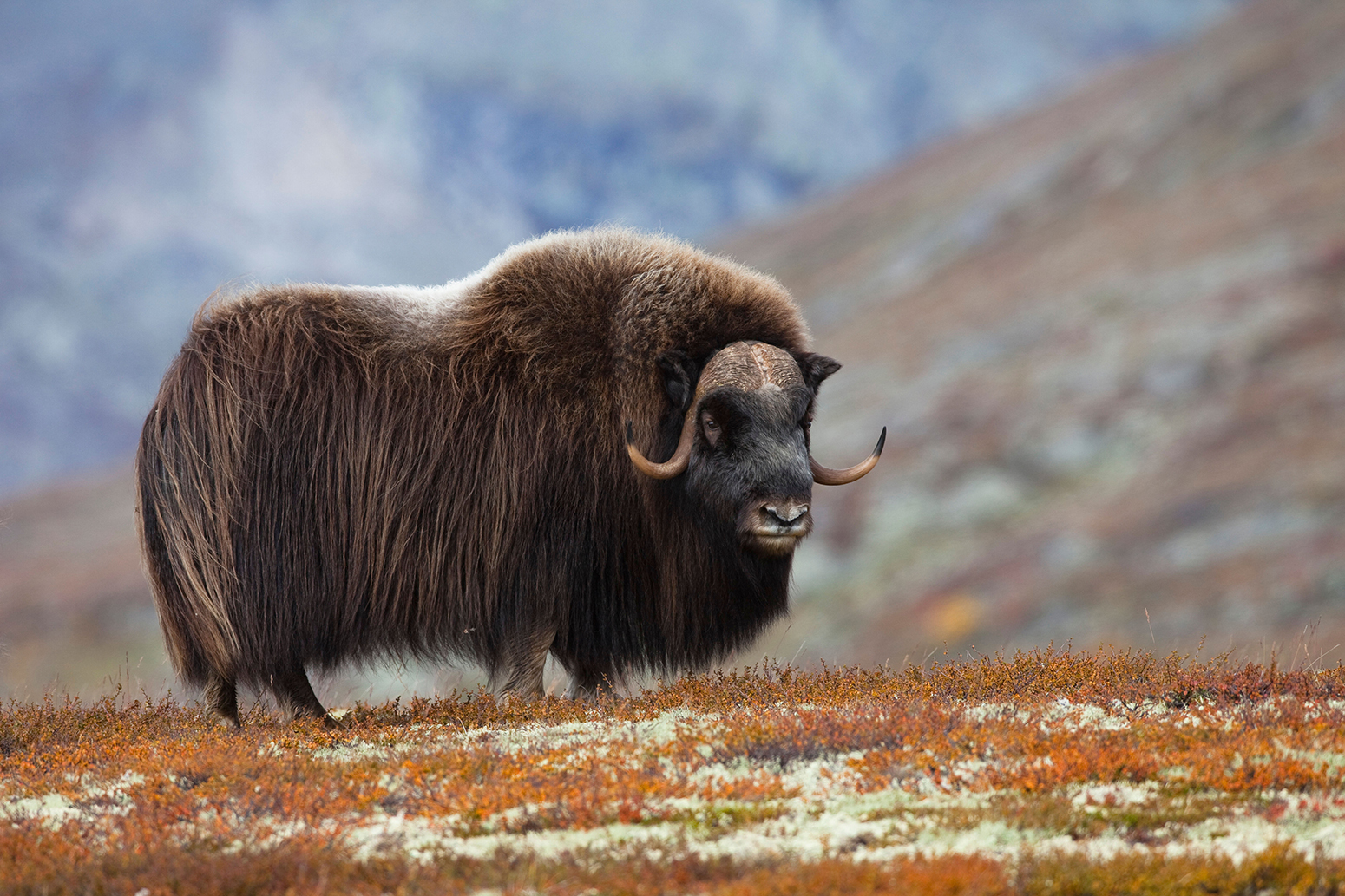
Male musk ox on tundra, DovrefjellSunndalsfjella National Park, Norway, 2010. Credit: Radius Images/Alamy Stock Photo.
However, it is difficult to draw meaningful conclusions on how climate change will affect other species that have mating systems involving fierce male-to-male competition, such as apes, seals and some birds. He adds:
“It is difficult to generalise, as this [sex ratios] will strongly depend on how climate change affects the environmental conditions that are important for survival. This may also vary not only with species, but with latitude and between coastal and inland populations.”
More research is needed to find out how climate change could affect the sex ratios of other, less well known animals, as well as plants, Laloë adds:
“There has been lots of research into how climate change could affect the sex ratios of sea turtles because people like them a lot, they are kind of like the pandas of the sea. Unfortunately this means that, comparatively-speaking, other species such as lizards and alligators are not receiving as much attention – even though these animals will doubtlessly be affected by climate change. Hopefully more research will be done in the future to remedy this.”


